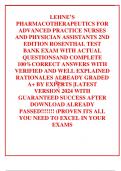Exam (elaborations)
LEHNE’S PHARMACOTHERAPEUTICS FOR ADVANCED PRACTICE NURSES AND PHYSICIAN ASSISTANTS 2ND EDITION ROSENTHAL TEST BANK EXAM WITH ACTUAL QUESTIONSAND COMPLETE 100%CORRECT ANSWERS WITH VERIFIED AND WELL EXPLAINED RATIONALES ALREADY GRADED A+ BY EXPERTS |LATEST
LEHNE’S PHARMACOTHERAPEUTICS FOR ADVANCED PRACTICE NURSES AND PHYSICIAN ASSISTANTS 2ND EDITION ROSENTHAL TEST BANK EXAM WITH ACTUAL QUESTIONSAND COMPLETE 100%CORRECT ANSWERS WITH VERIFIED AND WELL EXPLAINED RATIONALES ALREADY GRADED A+ BY EXPERTS |LATEST VERSION 2024 WITH GUARANTEED SUCCESS AFTER...
[Show more]



